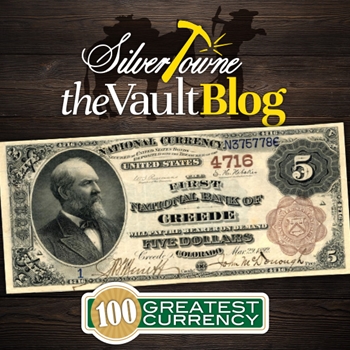
Upon the completion of a new Bureau of Engraving and Printing (BEP) facility in 1880, it gave way to a whole other level of capabilities when it came to new bank charters and the designing and engraving process of currency. This led to a Series of 1882 notes to be printed, including the next in our series covering the 100 Greatest American Currency notes as published by Whitman Publishing. As authors Q. David Bowers and David M. Sundman break down this top 100 pick, we take a look at how this specific currency note gave artists a chance to see their work displayed on a National Bank note.
#33 - Ornate Typography By the BEP $5 Brown Back National Bank Note, Series of 1882
Prior to the achievement of building a new BEP facility in 1880, the agency had to contract work outside of the bureau for almost 20 years. With the new facility in tow, staff engravers and artists were now able to design currency within the bureau. This gave them a plethora of opportunities to continue their growth and in 1882, The Banking Act of July 12th was passed and allowed for National Banks to extend their charters.
Upon renewal of charters or when new banks were formed, they were given new paper money with the Series 1882 imprint. Those note denominations consisted of the $5, $10, $20, $50, and $100. While paper money denominations $10-$100 were to continue using the Original Series designs on the face with a “revised” plate, the $5 denomination was completely redone with both plates and new designs. As mentioned earlier, this gave artists a chance to get their work seen on a National Bank note.
This $5 Brown Back National Bank note features the portrait of President James A. Garfield on the left of the face with the imprint of the bank in the center. The imprints are where artists were able to get expressive at the BEP as certain styles on the notes were deemed “circus poster” and “shingle” due to their letter styles. The Brown Back style also ended up being used on other Series 1882 denominations through $100 as they continued to be used into the 20th century.
Historic market value for this particular note, which 7,000-10,000 are estimated to be known, was $25 in 1960. By 2006, the same note was valued at $950. Notes with this style from rare towns and states have sold for more than $40,000 in Gem Uncirculated conditions.







